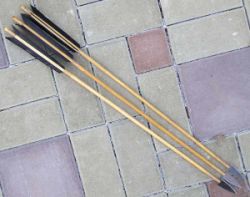arrow is a flying stick, and as such it flys quite differently than
does a bullet.
When an arrow is released not only is it being act upon by
gravity, making it a projectile, but also by air resistance, the force
exerted by the bow, and an arrows tendency to spin. accoutning
many of these forces and torques are the vanes of the arrow, or
the fletching. They help to stabilize the flight of the arrow, much
like wings on an aircraft.

From http://www.by-the-sword.com/
the gun, the arrow is the "ammunition" of the bow. This projectile, while thought of analogously to the bullet, is rather different from bullet in its design. Remember, an
arrow is fired from a large spring called a bow, therefore in the bow-arrow system, the elastic potential energy is transferred from the bow into the kinetic energy of the arrow.
This is true for the most part. There are some dampening forces involved such as the vibrations that the bow undergoes after being fired. These are dissipated throughout the
bow and usually are not harmful to the bow. However, when a bow is "dry fired", released with out an arrow, the energy that usually is imparted to the arrow is also
still present to take place in those vibrations. This can be harmful for the bow.
|
|
Another factor that must be considered in an arrow is an arrows ability to bend to one side or another during the firing of the bow. This can be seen in slow motion videos
taken of an arrow upon release. This produces an oscillation, or "wobble" in the flight of the arrow. This oscilation raquires energy and further removes it from the arrow.
Another factor involved in this bending of the arrow is the spine of the arrow. This is a measurement that takes into account the thickness of the wall of the shaft of the arrow,
and the diameter of the shaft. Also, many modern day arrows are hollow, raising the moment of inertia of the axis of the arrow helping to deny spin and retain energy
( Grundman, D. ).
Bibliography